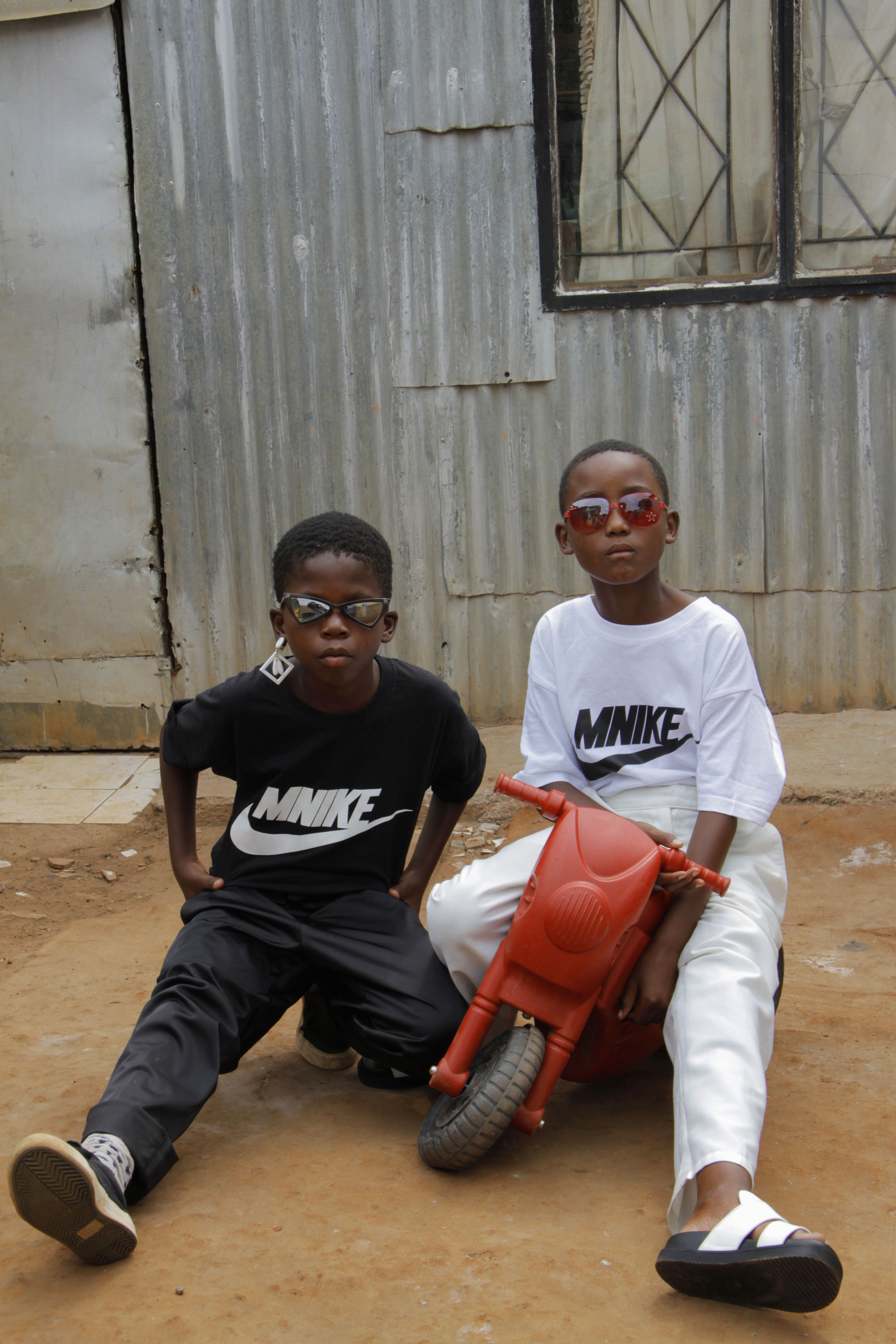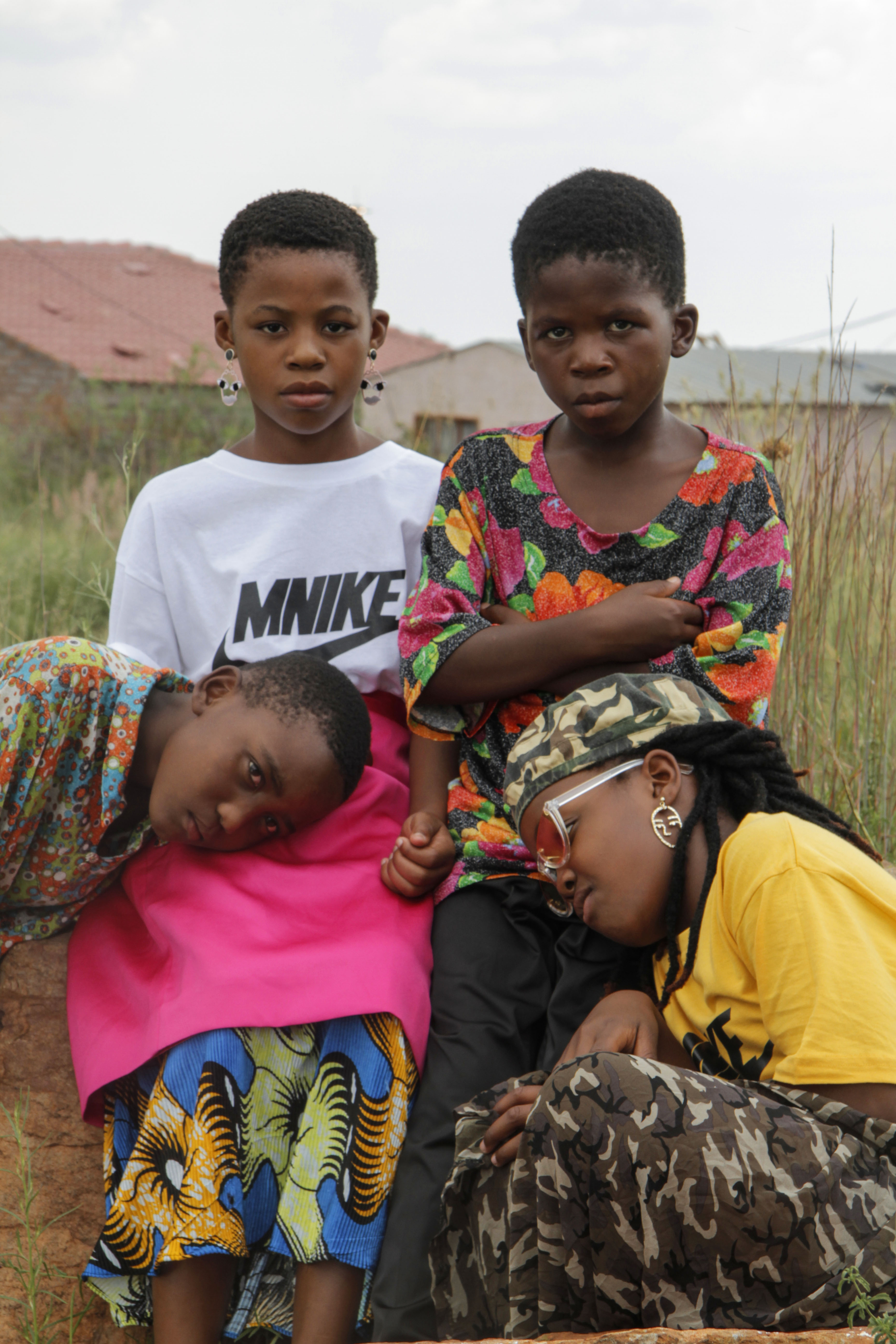'Faki'idata ngwana
At first glance, business partners and friends Lebogang Tlhako and Nati Kgobe bring the term “bag lady” to mind. This is because of the way they waddle when they carry the heavy satchels filled with the T-shirts they sell.
Their walks are reminiscent of bo mme under the tents in the central parts of cities — the merchants who carry their stock in large machangani bags from their selling points to the bus stops, on to the Putco bus, all the way home in the late weekday afternoons. Except Tlhako and Kgobe are the faces behind Mnike — a new streetwear line that has been recognised by one of Nike’s sportswear managers in the United Kingdom for making the celebrated brand their own.
Once mugs of ginger tea and glasses of cold water are served in the interview room at the Mail & Guardian offices, the pair drop their satchels and unpack their story.
Kgobe wears a black Mnike T-shirt, tailored black jeans and white Converse. Her relaxed hair is in a mushroom cut that compliments her online persona, a mamncane — who represents the stylish, sassy and young aunt we all expect to introduce us to the latest trends emgidini because she knows where to find all the good stuff at an affordable price ko China Mall or the Oriental Plaza.
Next to her, Tlhako sits back with her hands resting on her crossed legs. This shows off her suede lace-up boots that she pairs with capri pants, an oversized grey T-shirt and an Afro with a layered fringe.
To describe the collective Sho Ngwana only as the duo behind Mnike would be equivalent to enclosing their dynamic aspirations in a tightly sealed tupperware. Instead let us refer to them as a collective with the makings of ambassadors for bophelo ba ko kasi, township life — by taking pride in it on behalf of bo ngwana who may be discouraged by not seeing their mundane familiarities being displayed in popular culture on their own terms.
The T-shirt design was created when photographer Tlhako and Johannesburg streetwear muse Kgobe decided to make their dream of collaborating into a full-time job.
The T-shirts, delivered in the same tightly wrapped newspaper style that reminds me of being sent to Joe’s Meat Butcher to buy chuck, have been receiving attention on social media. With no disrespect, by adding the “M”, Sho Ngwana transforms Nike into an everyday South Africanism that speaks to botho ba rona while pressing play on the era around the year 2000 when Arthur Mafokate’s earwormy children’s anthem Mnike was released.
“We want to make art that speaks from a voice estwang ko kasi. Like, black people are the best thing to ever happen to us as black people. And we’re here to remind ourselves of that,” says Kgobe, who sits on the edge of her seat, illustrating her thoughts with the pictures she draws with her elaborate gestures.

[A picture from Sho Ngwana’s photo series that embodies their tagline “Si phakamisa ikasi, si phakamisa abo ngwana” (Lebogand Tlhako)]
The two met in 2012 after the one sent the other a Facebook request.
“It’s funny actually. I just sent her a friend request. She liked my style, so she suggested that we have a shoot, so we shot nje ko kasi yaka. The pictures came out so nice and that’s how we started our friendship,” Kgobe recalls.
On the eve of their friendship, Tlhako had decided to pursue a career in photography.
“After seeing Musa Nxumalo’s Alternative Kidz exhibition in 2008, I studied photography at the Market Photo Workshop in 2010,” she explains.
Kgobe was yet to complete her matric and, once she did, she pursued a career in the digital media space. She focused on brand promotion after being scouted and dubbed a tastemaker by Adidas, Levis and Woolworths.
“I think what sparked people’s interest was my feed and my engagement with users but it was mostly because of how I speak and carry myself. Ke ngwana ko kasi,” she boastfully exclaims between flu-recovery sniffs and ginger tea sips.
Growing up in Pimville and Katlehong, where they were exposed to fashion as a means of expression, their shared love for the sartorial made their partnership as easy as what Tlhako refers to as “fish and chips”. Not even the six-year age gap between the creatives, with Nati turning 24 and Lebogang being 30, could pose a hurdle.
“Rebatho bako kasi. That’s what brought us together.”
“Si phakamisa kasi, si phakamisa bo ngwana,” says Lebogang, completing Nati’s sentence with their tagline.
Although Sho Ngwana may have enticed people’s attention with the Mnike T-shirts, this is only the beginning.
The plan of action to phakamisa ikasi seeks to place Sho Ngwana into gallery spaces where they will showcase their ideas about performance art, photography and fashion. They hope such exhibitions will be the mirrors that inspire batho ba ko loxion to take themselves seriously by highlighting the beauty that has always existed.
But the T-shirts are still an important part of the process as they serve as a tangible resource that their consumers can take home as a humorous source of pride ya ko kasi.
“We wanna tell ditori based on how we grew up in the township; how we speak in the township, how we dress in the township. We use di example tsa ko kasi. Even our subjects and location ke ko kasi. We don’t compromise. We can’t compromise because that’s where we’re from. This is what we know Sho Ngwana is not an anthropology project,” says the more outspoken Kgobe, who looks to her partner for nods of approval.
But since they are yet to be recognised in such spaces, they did what all my mamncanes would do by making do with what they had.
Last month, Sho Ngwana hosted their very first instabition called Airsthetics. An instabition is a photographic exhibition hosted on Instagram using the feature the network adopted from Snapchat that allows users to post media that will disappear after 24 hours. Airsthetics showcased bophelo ba ko kasi with photography, music and fashion while drawing in new followers.

[Friends Sibusiso, Kutlwano, Nkateko and Kelebogile pose for Sho Ngwana’s Instabition ‘Airsthetics’ (Lebogang Tlhako)]
Airsthetics is comprised of photographs that look like they belong in the photo album that gogo would bring out and let me page through with her supervision to show me what my parents looked like as children. The photographs have the same sepia undertone and grainy feel that came with the pictures gogo arranged to be taken using the Kodak film cameras before photography went digital.
The subjects in Airsthetics are a group of children — Kutlwano, Nkateko, Sibusiso and Kelebogile — who are friends and live in Naledi, Soweto. As such, the setting is where children ko kasi always are, outside. Sometimes in front of a Zozo house, the neighbourhood hair salon or the taxi changing spot.
Like the pictures in vintage albums, the children seen in Airsthetics carry themselves with the same swag that our parents, aunts and uncles had — the type that cannot be packaged and sold, but only inherited.
“The concept of the instabition came from a place we were all once in. Growing up, our mothers had accounts ko Foschini le Jet and they came with magazines. When we would page through these magazines, haow it was just white people bathong. They didn’t speak to where we come from,” explains Kgobe.
“So we re-enact what we saw in those magazines because mmele basifake. We decided to feature just children because we were once those children who also wanted to be in those editorials. So we created an editorial for bo ngwana and that’s how the photo series came about.”
To this, Tlhako adds: “And so far ziyakhipa. The reception is confusing because the life we’re showcasing is something that we’re all exposed to. But then again it’s probably because we’ve needed something like this for a while.”
Kgobe and Tlhako agreed to meet me in between making deliveries. And, by the way their eyes keep darting down at their cargo, I can tell that our time together is nearing its end. You see, even though they get around by walking and kombing di taxi, they insist on delivering all T-shirts in person if the customer is based in Johannesburg.
“Yho, we get the T-shirts from very far. We source them from Crown Mines in Fordsburg near Langlaagte. We take taxis and walk. Even with making deliveries ke ka taxi. Today we’re in Rosebank, Ghandi Square then Braam. Ke lerato. As long as you’re in Jozi siyahlangana,” Tlhako assures me, with a never-say-die confidence as they place the satchels back on to their shoulders to start their Friday afternoon deliveries.
To see the instabition and purchase merchandise visit their shared Instagram page @sho_ngwana or @sisterbozza